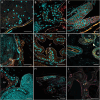Intracellular symbiont Symbiodolus is vertically transmitted and widespread across insect orders
- PMID: 38874172
- PMCID: PMC11322605
- DOI: 10.1093/ismejo/wrae099
Intracellular symbiont Symbiodolus is vertically transmitted and widespread across insect orders
Abstract
Insects engage in manifold interactions with bacteria that can shift along the parasitism-mutualism continuum. However, only a small number of bacterial taxa managed to successfully colonize a wide diversity of insects, by evolving mechanisms for host-cell entry, immune evasion, germline tropism, reproductive manipulation, and/or by providing benefits to the host that stabilize the symbiotic association. Here, we report on the discovery of an Enterobacterales endosymbiont (Symbiodolus, type species Symbiodolus clandestinus) that is widespread across at least six insect orders and occurs at high prevalence within host populations. Fluorescence in situ hybridization in several Coleopteran and one Dipteran species revealed Symbiodolus' intracellular presence in all host life stages and across tissues, with a high abundance in female ovaries, indicating transovarial vertical transmission. Symbiont genome sequencing across 16 host taxa revealed a high degree of functional conservation in the eroding and transposon-rich genomes. All sequenced Symbiodolus genomes encode for multiple secretion systems, alongside effectors and toxin-antitoxin systems, which likely facilitate host-cell entry and interactions with the host. However, Symbiodolus-infected insects show no obvious signs of disease, and biosynthetic pathways for several amino acids and cofactors encoded by the bacterial genomes suggest that the symbionts may also be able to provide benefits to the hosts. A lack of host-symbiont cospeciation provides evidence for occasional horizontal transmission, so Symbiodolus' success is likely based on a mixed transmission mode. Our findings uncover a hitherto undescribed and widespread insect endosymbiont that may present valuable opportunities to unravel the molecular underpinnings of symbiosis establishment and maintenance.
Keywords: genome erosion; insect symbiont; intracellular; mixed mode transmission; parasitism-mutualism continuum; secretion systems; transovarial; vertical transmission.
© The Author(s) 2024. Published by Oxford University Press on behalf of the International Society for Microbial Ecology.
Conflict of interest statement
The authors declare no competing interests.
Figures




Similar articles
-
The Cost of Metabolic Interactions in Symbioses between Insects and Bacteria with Reduced Genomes.mBio. 2018 Sep 25;9(5):e01433-18. doi: 10.1128/mBio.01433-18. mBio. 2018. PMID: 30254121 Free PMC article.
-
Versatile and Dynamic Symbioses Between Insects and Burkholderia Bacteria.Annu Rev Entomol. 2020 Jan 7;65:145-170. doi: 10.1146/annurev-ento-011019-025025. Epub 2019 Oct 8. Annu Rev Entomol. 2020. PMID: 31594411 Review.
-
Facultatively intrabacterial localization of a planthopper endosymbiont as an adaptation to its vertical transmission.mSystems. 2024 Jul 23;9(7):e0063424. doi: 10.1128/msystems.00634-24. Epub 2024 Jun 27. mSystems. 2024. PMID: 38934538 Free PMC article.
-
Strict host-symbiont cospeciation and reductive genome evolution in insect gut bacteria.PLoS Biol. 2006 Oct;4(10):e337. doi: 10.1371/journal.pbio.0040337. PLoS Biol. 2006. PMID: 17032065 Free PMC article.
-
Bacterial symbionts in insects or the story of communities affecting communities.Philos Trans R Soc Lond B Biol Sci. 2011 May 12;366(1569):1389-400. doi: 10.1098/rstb.2010.0226. Philos Trans R Soc Lond B Biol Sci. 2011. PMID: 21444313 Free PMC article. Review.
Cited by
-
How many do we need? Meeting the challenges of studying the microbiome of a cryptic insect in an orchard.Front Microbiol. 2025 Jan 6;15:1490681. doi: 10.3389/fmicb.2024.1490681. eCollection 2024. Front Microbiol. 2025. PMID: 39834370 Free PMC article.
-
The bacterial microbiome in spider beetles and deathwatch beetles.Microbiol Spectr. 2025 Apr 10;13(5):e0198124. doi: 10.1128/spectrum.01981-24. Online ahead of print. Microbiol Spectr. 2025. PMID: 40207924 Free PMC article.
References
-
- Margulis L, Fester R. Symbiosis as a Source of Evolutionary Innovation. Cambridge, MA: MIT Press, 1991XII, 454 s. - PubMed
MeSH terms
Grants and funding
LinkOut - more resources
Full Text Sources

